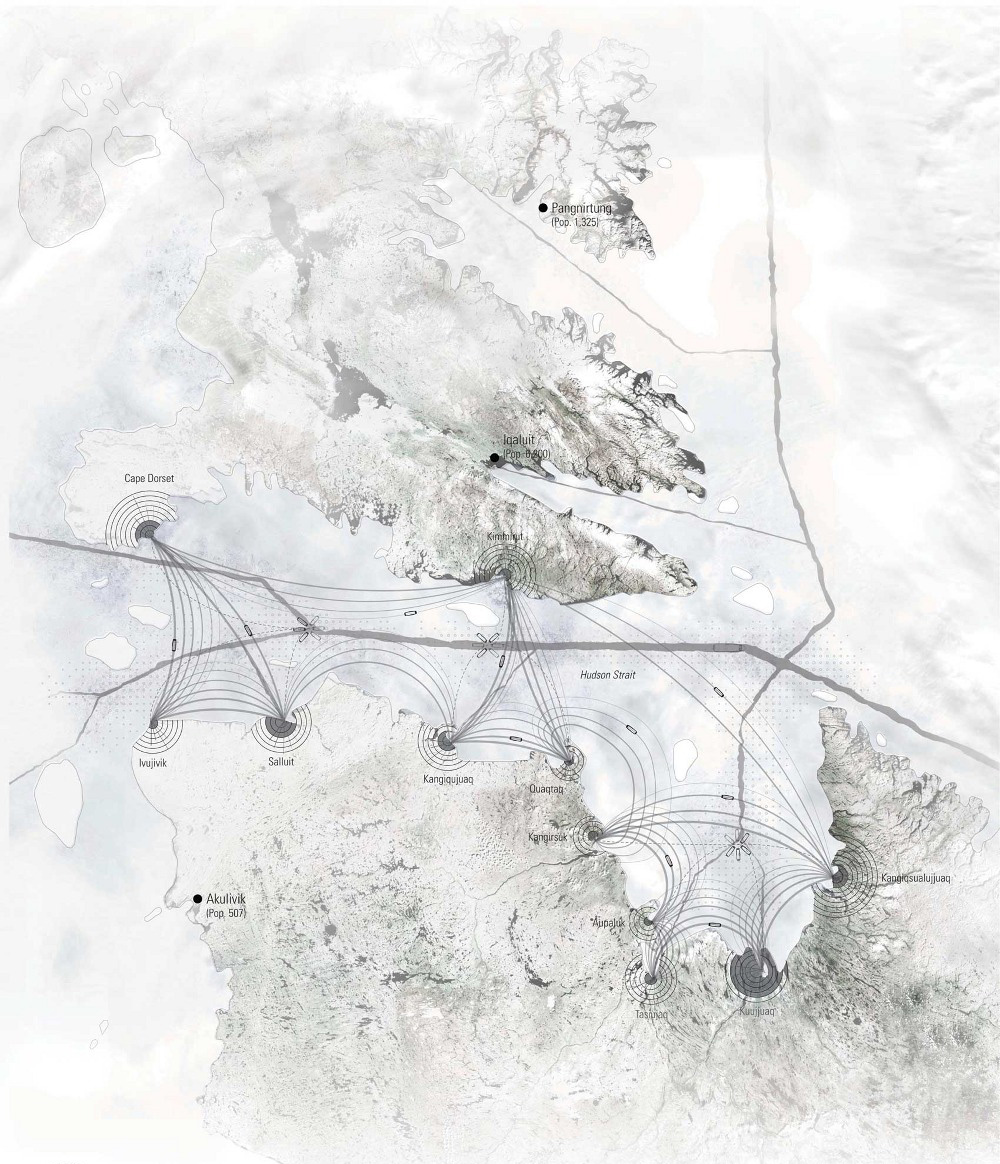|
 Lateral Office, Liquid Commons Unit: Mobile Arctic School. 2010. Project Map. Hudson Strait, NU / QC, Canada.
“Even if, during a transitional period, we temporarily accept a rigid division between zones of work and residence, we should at least envisage a third sphere: that of life itself (the sphere of freedom, of leisure – the truth of life). Unitary urbanism acknowledges no boundaries; it aims to form a unitary human milieu in which separations such as work/leisure or public/private will finally be dissolved.”
– Guy Debord, 1966
WHAT?

While Hong Kong has always been recognized as the best exemplar of contemporary vertical city, signs of our urban heritage can still be traced in the fishing villages distributed along our coastlines. The once dominated living pattern such as traditional sampans and floating living units has yet to be remembered.
The thesis envisions the feasibility of aquatic floating urbanization through revisiting these flexible primitive settlements. Possible sites are declining floating neighbourhoods such as Tam Shu Wan at Ma Wan, Pichic Bay in Lamma Island and Sam Mun Tsai in Tai Po. These organic urban fabrics, which have been adopted over the course of time, provide autonomous interaction between floating fish rafts, branched landings, communal moorings and impermanent water vehicles. Their spatial qualities of physical elasticity and uncertain mobility trigger expansion and regeneration of the thesis on urban living on water.
The project challenges rigid separation of our urban milieu. It explores mapping through examining the fluidity of these ambiguous marine structures and their vague edges with the land. Facing extensive open water, these sites develop the potentials of melting boundaries and water, and how these spaces might be exploited to a future of unitary urbanization. With a rich historic connection to the coastal margins and cultural backgrounds, not only shrinking fishing activities are reimposed, the project may stretch on diffusing private and public programmes such as retirement dwellings, self-sustained agricultural structures and community promenade.
WHY?

Although aquatic urbanism originates from humble vernacular architecture, architects have rediscovered ideas on waterborne living over various periods. Famous examples were visioned in metabolism movement in 1960s, such as the linear projection of city in Tokyo Bay by Kenzo Tange, and the floating metropolis with cylindrical towers in Marine City by Kiyonori Kikutake. These massive utopia proposals encouraged organic growths and self-sustainability through modular alternative living typologies.
With technological advancement, contemporary floating architecture has been carried out in coastal cities especially those which are under flood risks. In 2002, Waterstudio was established by Dutch architect, Koen Olthuis, as the first architectural firm dedicated to water living. While floating dwellings spreads along the Netherlands’ waterfront, urban concepts on water cities are yet unbuilt. While we face urban congestion and climate change, floating community is no longer a utopia, yet a foreseeable plan to be realized.
Masterpieces in the discipline although maybe impressive, they usually involve stationary mega infrastructures which isolate themselves to the shores. The thesis transforms water surface into an ambiguous volume through emphasizing its fluidity and movement. The dynamics happen at the boundaries, not only at the coastal edges but in between mobile transport and floating collectives. It embraces the permeation of substantial transient objects, and dissolves various programmes in blurring borders of the new urban community.
HOW?

Through mapping ambiguous boundaries of site and case studies, adaptation of mobile aquatectures, the thesis imagines a new blurring aquatic urban concept. Massing and modeling exercises further design organic circulation and flexible ephemeral spaces over different time phrases. The project will also explore flexible dwellings and self-sustained systems through drawings and studying models.
Step01: Map processes and data of fix and dynamics of site, investigate autonomous processes in aquatectures such as sampan and floating architecture and their mobile relation to water and boundaries;1:2000~1:1000 drawings
Step02: Case studies of Constant Nieuwenhuys and Sou Fujimoto; Design urban layout and circulation through overlaying step01 analysis; transform into time evolution in 1:1000~1:500 urban master plan and massing models
Step03: Develop self-sustained living dwellings, agricultural and energy systems of infrastructures in 1:500~1:100 section and studying models
Step04: Refine and test on final areas in urban master plan, buildings and dwellings organization
BIBLIOGRAPHY
Debord, Guy. The Society of the Spectacle. Berkeley: Bureau of Public Secrects, 1967. Print.
Nieuwenhuys, Constant. Labyrinth-Ladder for New Babylon, 1959. Unbuilt.
Banham, Reyner. Megastructure: Urban Futures of the Recent Past. New York: Harper and Row, 1976. Print.
Solomon, Jonathon & Wang, Clara. Cities Without Ground: A Hong Kong Guidebook. Hong Kong: Oro Editions, 2012. Print.
Fujimoto, Sou. Sou Fujimoto: Primitive Future. Tokyo: Inax, 2008. Print
Loes Nillesen, Anne & Singelenberg Jeroen. Amphibious Housing in the Netherlands. Rotterdam: NAi Publisher, 2011. Print
Olthuis, Koen & Keuning David. Float!: Building on Water to Combat Urban Congestion and Climate Change. Amsterdam: Frame Publisher. 2010. Print
Kloos Maarten & Korte, Yvonne. Mooring site Amsterdam: Living on water. Amsterdam: ARCAM/ Architectura & Natura Press, 2007. Print
|